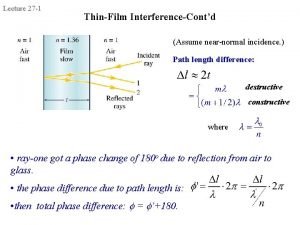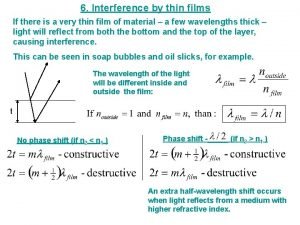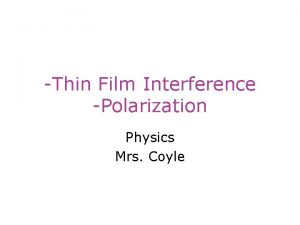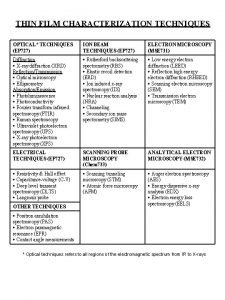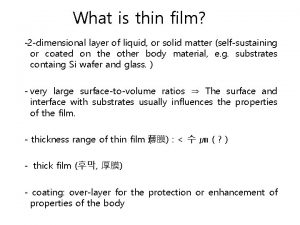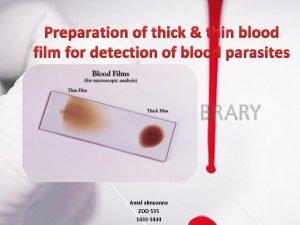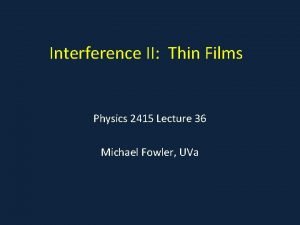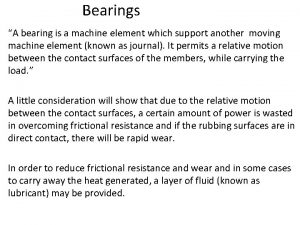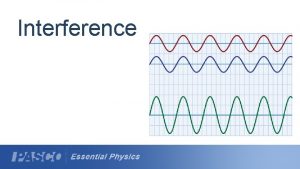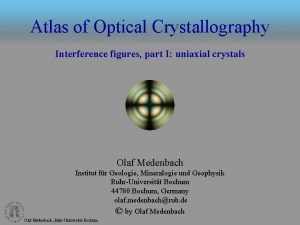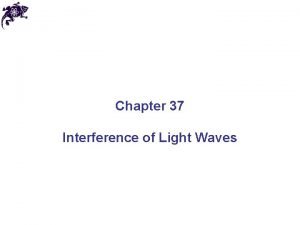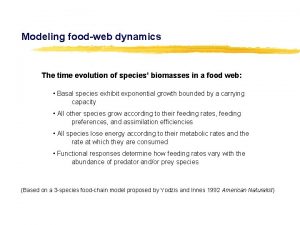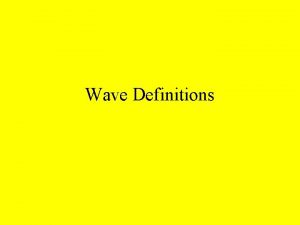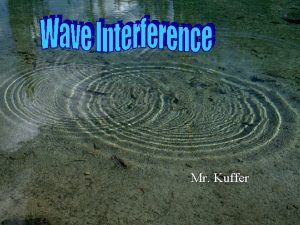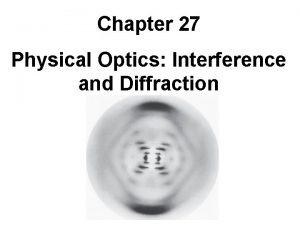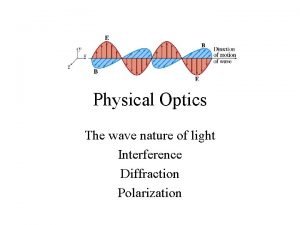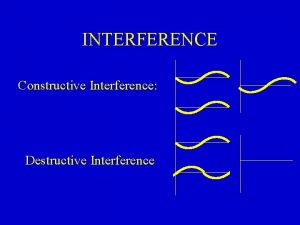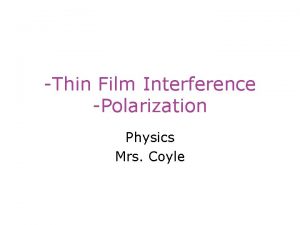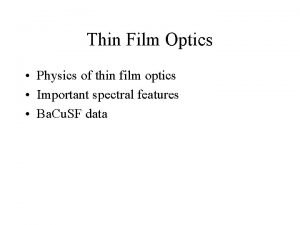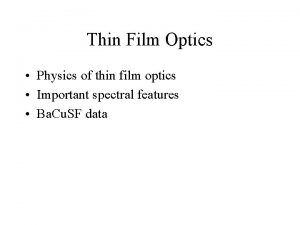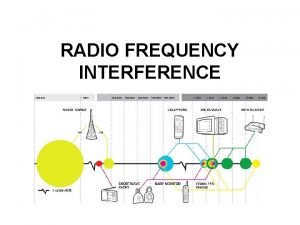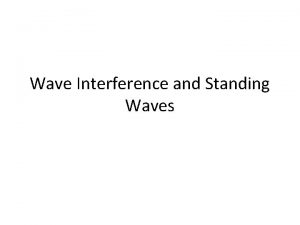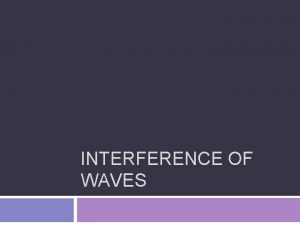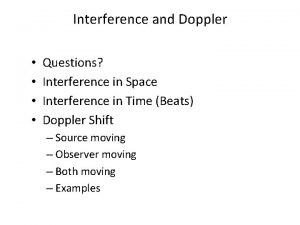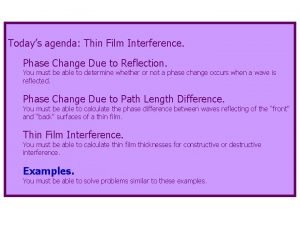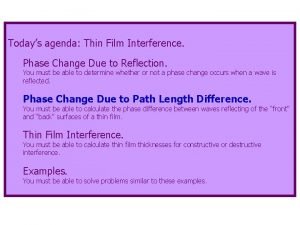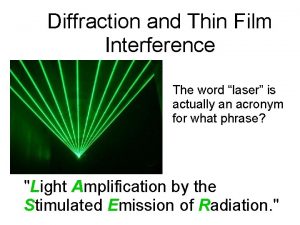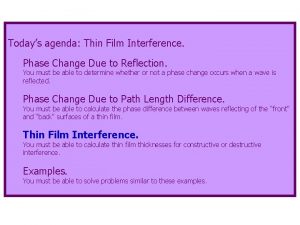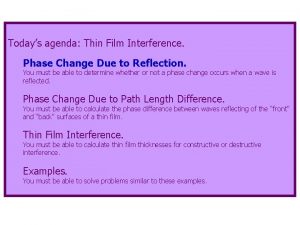Thin film interference v Thin film interference occurs


























- Slides: 26

Thin film interference v. Thin film interference occurs when light is reflected from the top surface and the underneath surface. v. This provides the two beams of coherent light that interfere. v. Since we normally observe this with white light we see colors because the path difference varies depending on the angle of observation v. So different wavelengths (colors) have constructive and destructive interference at different places on the film. Physics 214 Fall 2010 10/18/2021 1

Diffraction v. Interference occurs even for a single aperture and this is called diffraction. The pattern shown is from a square aperture and the pattern can be thought of as light from different parts of the aperture interfering. v. As the aperture is made smaller the pattern actually expands. v. This effect can limit our ability to see detail in small objects or to resolve two The position of the first dark fringe stars nearby to one another. is given by y = λx/w. This means the central bright fringe has a width ~ 2 y and increases as w gets smaller That’s why the telescope with bigger aperture see clearer. Physics 214 Fall 2010 10/18/2021 2

v Thomson’s discovery provided the first known subatomic particle. l l l The mass of an electron is 9. 1 x 10 -31 kg. The charge of an electron is 1. 6 x 10 -19 C. The electron was the first possible candidate for a building block of atoms. v The study of cathode rays led Roentgen to discover yet another type of radiation.

Blackbody Radiation

Quantization of light energy v Planck derived a formula that described the distribution of wavelengths emitted, depending on the temperature. l His formula required that light could only be absorbed or emitted in discrete chunks or quanta, whose energy depended on the frequency or wavelength. where h = 6. 626 x 10 -34 J s is called Planck’s constant. v This idea was indeed radical. v Einstein showed that the quantization of light energy explains a number of other phenomena. v Photoelectric effect. v The idea of light quanta (photons) having energies E = hf prepared the way for a new model of the atom.

Bohr’s model of the atom v Bohr combined all these ideas: l l the discovery of the nucleus knowledge of the electron the regularities in the hydrogen spectrum the new quantum ideas of Planck and Einstein v He pictured the electron as orbiting the nucleus in certain quasi-stable orbits. v Light is emitted when the electron jumps from one orbit to another. v The energy between the two orbits determines the energy of the emitted light quantum.

Bohr’s model of the atom v The hydrogen spectrum can be explained by representing the energies for the different electron orbits in an energy-level diagram.

What is the wavelength of the photon emitted in the transition from n = 4 to n = 2? Note: h = 6. 626 x 10 -34 J s = 4. 14 x 10 -15 e. V s A. 487 nm B. 4000 nm C. 12 nm D. 66 nm E. 2000000 nm

What is the wavelength of the photon emitted in the transition from n = 4 to n = 2? ∆E = E 4 - E 2 = - 0. 85 e. V - (-3. 4 e. V) = 2. 55 e. V E = hf where h = 6. 626 x 10 -34 J s = 4. 14 x 10 -15 e. V s f=E/h = (2. 55 e. V) / (4. 14 x 10 -15 e. V s) = 6. 16 x 1014 Hz l= c / f = (3 x 108) / (6. 16 x 1014 Hz) = 487 nm

The Structure of the Nucleus v Rutherford. Bombarded nitrogen gas with alpha particles l l l A new particle emerged We now call this particle a proton. Charge +e = 1. 6 x 10 -19 C Mass = 1/4 mass of alpha particle, 1835 x mass of electron v Bothe and Becker bombarded thin beryllium samples with alpha particles. l l A very penetrating radiation was emitted. Originally assumed to be gamma rays, this new radiation proved to be even more penetrating. v Chadwick determined it was a new particle which we now call neutron. l l No charge -- electrically neutral Mass very close to the proton’s mass

v The basic building blocks of the nucleus are the proton and the neutron. l l Their masses are nearly equal. The proton has a charge of +1 e while the neutron is electrically neutral. v This explains both the charge and the mass of the nucleus. l An alpha particle with charge +2 e and mass 4 x mass of the proton is composed of two protons and two neutrons. l A nitrogen nucleus with a mass 14 times the mass of a hydrogen nucleus and a charge 7 times that of hydrogen is composed of seven protons and seven neutrons.


v This also explains isotopes. l Atoms of the same element can have different values of nuclear mass. l l Different isotopes have the same number of protons in the nucleus, but different numbers of neutrons. Two common isotopes of chlorine both have 17 protons, but one has 18 neutrons and the other has 20 neutrons. l The chemical properties of an element are determined by the number and arrangement of the electrons outside of the nucleus. l For a neutral atom with a net charge of zero, the number of electrons outside the nucleus must equal the number of protons inside the nucleus. This is the atomic number. The total number of protons and neutrons are called mass number l

Plutonium-239 is a radioactive isotope of plutonium produced in nuclear reactors. Plutonium has an atomic number of 94. How many protons and how many neutrons are in the nucleus of this isotope? a) b) c) d) e) 94 protons, 94 neutrons 94 protons, 145 neutrons 145 protons, 94 neutrons 94 protons, 239 neutrons 239 protons, 94 neutrons With an atomic number of 94, all isotopes of plutonium have 94 protons. The isotope plutonium-239 has 239 - 94 = 145 neutrons.

Alpha decay v Alpha particle is one of the decay product. l For example, Marie and Pierre Curie isolated the highly radioactive element radium (88 Ra 226) which emitted primarily alpha particles. l The dominant isotope of radium contains a total of 226 nucleons: 88 Ra 226 l The atomic number, 88, is the number of protons. l The mass number, 226, is the total number of protons and neutrons. l When radium-226 undergoes alpha decay, it emits an alpha particle (2 protons and 2 neutrons). l The nucleus remaining after the decay has 88 - 2 = 86 protons, 226 4 = 222 nucleons, and 222 - 86 = 136 neutrons. l This is the element radon-222.

v Beta decay is the emission of either an electron or a positron (the electron’s antiparticle). l For example, lead-214 emits an electron. l One of the neutrons inside the nucleus changes into a proton, yielding a nucleus with a higher atomic number. l In the process, an electron is emitted (to conserve charge) and a neutrino (or in this case, an antineutrino, the neutrino’s antiparticle) is emitted to conserve momentum.

v Gamma decay is the emission of a gamma particle or photon. l The number of protons and of total nucleons does not change. l The nucleus decays from an excited state to a lower energy state. l The lost energy is carried away by the photon.

Quiz: Among the following transition in atomic hydrogen, which gives radiation of the longest wavelength (i. e. lowest energy)? A. n=4 to n=2 B. n=4 to n=3 C. n=3 to n=2.

Backups

v Different radioactive isotopes have different average times that elapse before they decay. v The half-life is the time required for half of the original number of atoms to decay. l For example, the half-life of radon-222 is about 3. 8 days. §If we start with 20, 000 atoms of radon-222, 3. 8 days later we would have 10, 000 remaining. §After 7. 6 days, half of the 10, 000 would have decayed, leaving 5, 000. §After three half-lives, only 2500 would remain. §After four half-lives, only 1250 would remain.

If we start with 10, 000 atoms of a radioactive substance with a half-life of 2 hours, how many atoms of that element remain after 4 hours? a) b) c) d) e) 5, 000 2, 500 1, 250 625 0 After 2 hours (one half-life), half of the original 10, 000 atoms have decayed, leaving 5, 000 atoms of the element. After 4 hours (two half-lives), half of that remaining 5, 000 atoms have decayed, leaving 2, 500 atoms of the original element.

We are exposed to radiation every day. How much exposure is likely to be dangerous? • “Rem” stands for “roentgen equivalent in man” and is a unit for measuring amounts of ionizing radiation. • A whole-body dose of 600 rems is lethal. • Currently radiation workers are allowed no more than 5 rems/yr. • Smaller doses are measured in millirems (mrems). http: //www. new. ans. org/pi/resources/dosechart/ Natural sources mrems/yr inhaled radon cosmic rays terrestrial radioactivity internal radioactivity 200 27 28 40 Total: 295 Human-produced mrems/yr sources medical consumer products other Total: 53 10 1 64

Mass and Energy Mass and energy are related according to above equation.

Nuclear Reactions and Nuclear Fission v In addition to spontaneous radioactive decays, changes in the nucleus may be produced experimentally through nuclear reactions.

Fermi attempted to produce new elements by bombarding uranium with neutrons. 2 He 4 + 4 Be 9 6 C 12 + 0 n 1

Quiz: If we start with 10, 000 atoms of a radioactive substance with a half-life of 2 hours, how many atoms of that element remain after 8 hours? a) b) c) d) e) 5, 000 2, 500 1, 250 625 0
 Thin film interference
Thin film interference Interference in thin film
Interference in thin film Interference in thin film
Interference in thin film Thin film interference
Thin film interference Proactive interference vs retroactive interference
Proactive interference vs retroactive interference Proactive interference vs retroactive interference
Proactive interference vs retroactive interference Ultra large scale integrated circuit
Ultra large scale integrated circuit Thin film characterization techniques
Thin film characterization techniques Fiber texture pole figure
Fiber texture pole figure Tablet opaquant
Tablet opaquant What is thin film
What is thin film Sputtering yield
Sputtering yield First minima in diffraction
First minima in diffraction Thick and thin film preparation
Thick and thin film preparation Pvc membrane film
Pvc membrane film What is thin film in physics
What is thin film in physics Wedge film journal bearing
Wedge film journal bearing Wave interference investigation
Wave interference investigation Interference figure of quartz
Interference figure of quartz The curves that satisfy fundamental law of gearing are,
The curves that satisfy fundamental law of gearing are, Constructive interference formula
Constructive interference formula Type of interference
Type of interference What is elastic medium
What is elastic medium Draw the interference pattern for the two waves
Draw the interference pattern for the two waves Constructive interference example
Constructive interference example Which principle
Which principle Constructive and destructive interference
Constructive and destructive interference

